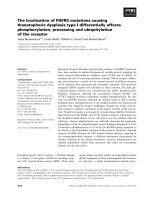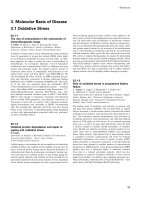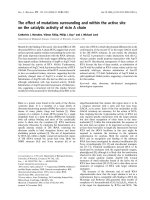Tài liệu Báo cáo khoa học: "The Use of Ooject-Special Knowledge in Natural Language Processing" doc
Bạn đang xem bản rút gọn của tài liệu. Xem và tải ngay bản đầy đủ của tài liệu tại đây (497.42 KB, 6 trang )
The
Use of Ooject-Specl flc
Knowledge in
Natural
Language
Processing
Mark
H. Bursteln
Department of Computer Science, Yale University
1.
INTRODUCTION
it is widely reco~nlzed that the process of
understandln~ natural language texts cannot be
accomplished
without
accessin~
mundane Knowledge about
the
world [2, 4,
6, 7]. That is, in order to resolve
ambiguities, form expectations,
and make
causal
connections between events, we must make use of all
sorts of episodic, stereotypic and factual knowledge.
In
this
paper,
we are concerned with the way functional
knowledge of objects, and associations between objects
can
be exploited in an understandln~ system.
Consider
the sentence
(1) Jonn opened the Oottle so he could pour the wine.
Anyone
readin~
this
sentence
makes assumptions about
what happened which go far beyond what is stated. For
example, we assume without hesitation that the wine
beln~ poured came from inside the bottle. Although this
seems quite obvious, there are many other
interpretations wnlcn are
equally valid.
Jonn could
be
fillin~ the bottle rather than emptyln~ the wine out of
it. In fact,
it
need
not
be true that the
wine
ever
contacted the bottle. There
may have been
some other
reason Jonn had to open the bottle first. Yet, in the
absence of a larger context, some causal inference
mechanism forces us (as human understanders) to find the
common interpretation in the process of connecting these
two events causally.
In interpreting this sentence, we also rely on an
understanding of what it means for a bottle to be
"open". Only by
usin~
Knowledge
of what is
possible
when a bottle Is open are able we understand why John
had to open the Pottle to pour the wine out of It.
Stron~ associations are at work here nelpin~ us to
make
these connections. A sentence such as
(2) John closed the bottle
and
poured the wine.
appears
to
be self contradictory only because we assume
that the wine was in the bottle before applyln~ our
knowledge of open and closed bottles to the situation.
Only
then do we realize that closing the bottle
makes
it
impossible to pour the wine.
Now consider the sentence
(3) John turned on the faucet and filled his glass.
When reading this, we immediately assume that John
filled his glass with water from the faucet. Yet, not
only is water never mentioned in the sentence, there is
nothing there
to
explicitly relate turning on
the
faucet
and
filling the glass. The glass could conceivably
be
filled with milk from a carton. However, in the absence
of some greater context which forces a different
interpretation on us, we immediately assume that the
glass is being filled with water from the faucet.
Understanding
each of these sentences requires that we
make use of associations we have In memory between
oPJects and actions commonly InvolvlnE those objects, as
• This wore was supported in part by the Advanced
Research Projects Agency of the Department of Defense
and monitored by the Office of Naval Research under
contra:t N0001~-75-C-1111.
well as relations between several different objects.
This paper describes a computer program, OPUS (Object
Primitive Understanding System)
which
constructs a
representation of
the
meanings of sentences such as
those
above,
including
assumptions
that a human
understander
would
normally make, by accessin~
these
types of associative memory structures. This
stereotypic knowledge of physical objects Is captured in
OPUS
using Object Primitives [5]. Object Prlmitlves
(or) were designed to act in conjunction with Scnank's
conceptual dependency representational system [11]. The
processes developed to perform conceptual analysis in
OPUS involved the integration of a conceptual analyzer
similar to RlesOec~'s ELl [g] with demon-like procedures
for memory interaction
and the
introduction of
object-related inferences.
2.
OBJECT PRIMITIVES
The primary focus In this research has been on the
development of processes
which
utillze
Information
provided by Object Primitives to facilitate the
"comprehension" of natural language texts by computer.
That
Is, we were primarily
concerned
with the
introduction
of
stereotyplc
knowledge of objects into
the conceptual analysis of
text.
By encoding
information in OP descriptions, we were able to increase
the interpretive power of the analyzer in order to
handle sentences of
the
sort discussed earlier.
What follows Is a brief description of the seven Object
Primitives. A more thorough discussion can be found in
[5]. For those unfamiliar with the primitive acts of
Schank's conceptual dependency theory, discussions of
wnlch can be found in [10,11].
The Object Primitive CONNECTOR Is used to indicate
classes of actions (described in
terms of
Sohank*s
primitives acts) which are normally enabled by the
object being described. In particular, a CONNECTOR
enables actions between two spatial regions. For
example, a window and a door are both CONNECTORs which
enable motion (PTRANS) of objects through them when they
are open. In addition, a window Is a CONNECTOR which
enables the action ATT£ND eyes (see) or MTRANS
(acquisitlon of Information) by the instrumental action
AI"rEND eyes. These actions are enabled regardless of
whether the window is open or closed. That Is, one can
see through a window, and therefore read or observe
things on the other side, even when the window is
closed. In the examples discussed above, the open
bottle ls glven a CONNECTOR description, rnis will be
discussed
further later.
A SEPARATOR disenables a transfer between two spatial
regions. A closed door and a closed window are both
SEPARATORs which dlsenable the motion between the
spatial regions they adjoin. In addition, a closed door
is a SEPARATOR which dlsenables the acts MTRANS by
A~END eyes (unless the door is transparent) or ears.
That Is, one is normally prevented from seeing or
hearing through a closed door. Similarly, a closed
window is a SEPARATOR which dlsenables MTRANS with
Instrument ATTENO ears, although, as mentioned aoove,
one can
still see through a closed window to the other
side. A closed bottle is another example of an object
with
a
SEPARATOR
description.
It should be clear by now that objects de,bribed using
Object Primitives are not generally described by a
single primitive. In fact, not one out several sets of
53
primitive descriptions may be required. This Is
illustrated above by the combination of CONNECTOR and
SEPARATOR descriptions required
For
a closed window,
while
a somewhat different set Is
required For
an
open
window. These sets of descriptions form a small set of
"states" which the object may Oe in, each state
corresponding
to a set of inferences and asSociations
approriate to the object in that condition.
A
SOURCE
description indicates that a aajor function of
the object described is
to
provide the user of that
object with some other object. Thus a Faucet
is
a
SOURCE o[ water, a wtne bottle ls a SOURCE of wine, and
a lamp is a SOURCE of the phenomenon called light.
SOURCEs often require some sort of activation. Faucets
must be turned on, wine bottles must be opened, and
lamps are either turned on
or
lit depending on whether
or
not they are elsctrJo.
The Object Frlmltlve CONSUMER Is used to describe
objects
whose
primary
Function Is to cons, me other
objects. A trash can is a CONSUMER of waste
paper,
a
draln is a CONSUMER of liquids, and a mailbox ts a
CONSUMER of
mail.
Some
objects are both SOURCEs and
CONSUMERS. A
pipe
is a CONSUMER of tobacco and a SOURCE
of smoke.
An
Ice cube
tray
Is a
CONSUMER
of water
and
a
SOURCE of ice cu~es.
Many objects can be described In part by relationships
that
they
assu~e with some other
objects.
These
relations are described ustn~ the Object Primitive
RELATZONAL.
Containers, such as bottles, rooms, cars,
etc., have as part of their descriptions a containment
relation, which may specify defaults For
the type of
object contained.
Objects, such as
tables and
chairs,
wnloh
are commonly used to support other objects will be
described with a
support
relation.
Objects such as buildings, cars, airplanes, stores,
etc., are all things which
can
contain people. As
such,
they
are often distinguished by the activities which
people in those places engage in. One important way OF
encoding those activities is by referring to the scripts
which describe them. The Object Primitive SETTING is
used
to
capture the asscclatlons between a place and any
script-like
activities
that
normally occur
there.
It
can also be used to indicate other, related SETTINGs
which the object
may be
a part of. For
example,
a
dinin~
car has a SETTING description wlth a llnK both
to
the restaurant script and to the SETTING For passenger
train. This information Is important For the
establishment OF relevant contexts, giving
access to
many
domain specl/lc expectations which wlll
subsequently
be available
to guide
processtn~
~oth
during conceptual analysis of lexical input and when
making InFerences at higher levels oF
nogntttve
processing.
The
Final
Object Primitive, GESTALT, is used to
characterize objects which have recognizable, and
separable, eubparts. " Trains, hi-Fi systems, and
Kitchens, all evoke Images of objects charaoterlzable
by
describing their subparts, and the way that those
subparts
relate
to fOrm
the whole. The OcJect Primitive
GESTALT is used to
capture
this type
of
description.
Using
thls set
of
prlmltlves as
the Foundation For
a
memory representation,
we
can
construct a
more general
hi-directional associative memory by introducing some
associative
links external
to
object
primitive
decompositions. For example, the conceptual description
of a wine bottle will Include a SOURCE description For a
bottle where the SOURCE output is specified as wine.
This amounts to an associative link From the concept OF
a wine bottle to the concept of wine. But how can we
construct an assoolatlve llnK
From
wlne back to wlne
bottles? ~lne does not have
an
object primitive
decomposition wnloh
involves
wine bottles, so we must
resort to some construction which Js external to object
primitive decompOsitions.
Four associative links have been proposed [5], each of
which pOints to a particular object primitive
description. For the problem of wine and wine Dottles,
an associative OUTPUTFROH link is directed from wlne to
tne SOURCE description of a wine bottle. This external
link provides us with an associative link From wine to
wine bottles.
3.
I~U~ROORAM
I will now describe the processing
ot two
sentences very
similar to those discussed earlier. The computer
program (OPUS) which performs the Following analyses was
developed usin~ a con:eptual analyzer written by Larry
Eirnbaum [1]. OPUS was then extended to include a
capacity For setting up and Firing "demons" or
.triggers" as they are called In K~L [3]. The
Functioning of these demons will be Illustrated below.
3.1 THE INITIAL ANALXSIS
In the processing of the sentence "Jo~n opened the
bottle so he could pour the wine," the phrase "John
opened the bottle," is analyzed to produce the Followin~
representation:
SJohne : eDOe
result
ehottlee
CONNECTOR
ENABLES
?HUMO <:> PTRANS ~- ?OBJ < ~>
?X
L.
<
(INSIDE
SELF)
(or)
>
(INSIDE
SELF)
r-
PTRANS
<-
?OBJ
<-~
?HUMO
<=>
L-
< ?¥
(or)
?HUMO <=> A'r'rzSD <. ?S£NS£ < E~ ?OBJe
• (where ?OBJ Is inside SELF)
Here 3ELF refers to the object bein~ described (the
bottle) and ? indicates an unfilled slot. eJohne
here stands For the internal memory representation For a
person wlth the name John. Memory tokens rot John and
the bottle are constructed by a general demon which
is
trtg&ered during conceptual analysis whenever a PP (the
internal representation For an object) is Introduced.
OF descriptions are attached to each object token.
This dtagrem represents the assertion that John did
something which caused the bottle to assume a state
where its CONNECTOR description applied. The CONNECTOR
description indicates that something can be removed from
the bottle, put into the bottle, or Its contents can be
smelled, looked at, or generally examined by some sense
modsltty. This CONNECTOR description Is not part oF the
definition of the
word
'open'. It
is
specific Knowledge
that people have about what it means to say that a
~ottle IS open.
In striving
at the
~bove representation, the program
must retrieve From memory this OF description of what it
means For a bottle
to
be open. This information is
stored Peneath its prototype
For
bottles. Presumably,
there Is also script-like information about the
different methods For opening
bottles,
the different
types of caps (corks, twist-off, ), and which method
is appropriate For which cap. However, For the purpose
of understanding a text which does not re/er to a
specific type of bottle, asp, or opentn~ procedure,
what
is important is the information aoout how the bottle
can
54
then be used once it is opened. This is
the
kind
of
knowledge
that OOJect Primitives were
designed
to
capture.
When the analyzer builds the state description of the
bottle, a general
demon
associated with
new
state
descriptions is triggered. This demon is responsible
for updating memory by adding the new state information
to the token in the ACTOR slot of the state description.
Thus the bottle token is updated to include the gtven
CONNECTOR
description.
For the
purposes of
this
program, the bottle is then considered to be an "open"
bottle. A second function of this demon is to set up
explicit expectations for future actions based on the
new information. In this case, templates for three
actions the program might expect to see described can be
constructed from
the three partially
specified
conceptualizations
shown
above
In
the
CONNECTOR
description of
the
open bottle.
These templates
are
attached to the state descrJptlon as possible
consequences of that state, for use when attempting to
infer the causal connections between events.
3.2 CONCEPT
DRIVEN INFERENCES
The phrase "so ne could pour the wine." Is analyzed as
eJohn~
~.>
enable
PTRANS
<- ewinee <~_>F
?X
i
< (INSIDE ?CONTAINER)
When thls representation is built
by
the analyzer, we do
not know that the the wine being poured came from the
previously mentioned bottle. This inference Js made in
the program by a slot-filling demon called the
CONTAINER-FINDER,
attached
to
the
primitive
act
PTRANS.
The demon, triggered when a PTRANS from Inside an
unspecified container is built, looks on the iist of
active tokens (a part of snort term memory) for any
containers that
might
be
expected to contain
the
substance moved, in this case wine. This is done by
applying
two tests to the objects
In
snort term memory.
The
first, the DEFAULT-CONTAINMENT test, looks
for
objects
described by
the RELATIONAL primitive,
indicating
that
they
are
containers (link =
INSIDE)
with
default object contained being wine. The second, the
COMMON-SOURCE test, looks for known SOURCEs of wine by
following the
associative OUTPUTFROM
link from wlne.
If
either of these tests succeed, then the
object
found is
inferred
to
be the container poured from.
At
dlfferent times,
either
the
DEFAULT-CONTAINMENT
test
or the COMMON-SOURCJ~ test may be necessary in order to
establish
probable containment. For
example,
it
is
reasonable
to
expect a vase to contain water since
the
RELATIONAL
description
of
a
vase has
default
containment
slots for water and flowers. But we
do
not always
expect water to come from vases since there is
no
OUTFUTFROM link from water
to
a SOURCE description of a
vase.
If we heard "Water spilled when
John bumped
the
vase," containment would be established
by
the
DEFAULT-CONFAINMENT
test. AssoclatJve links are
not
always hi-directional (vase > water, but water -/->
vase) and we need separate mechanisms to trace links
with different orlentatlons. In
our
wine
example,
the
COMMON-SOURCE test Is responsible for establishing
containment, since wine is known to be OUTPUTFROM
bottles
but
bottles are not always assumed to hold wine.
Another inference made
during
the
initial
analysis finds
the contents
of
the bottle mentioned in the first clause
of the sentence. Thls expectation was set up by a demon
called the
CONTENTS-FINDER
when the description of the
open bottle, a SOURCE with unspecified output, was
built. The demon causes a search of STM for an object
which could De OUTPUT-FROM a bottle, and the token for
this particular bottle is then marked as being a SOURCE
of that oCject. The description of this particular
bottle as a SOURCE of wine Is equivalent, in Object
Primitive terms, to sayin~ that the bottle is a wine
bottle.
3.3 CAUSAL VERIFICATION
Once the requests
trying, to
fill slots not filled during
the
initial
analysis nave been considered, the process
which attempts to
find
causal connections between
conceptualizations is activated, in this particular
case, the analyzer has already indicated that the
appropriate
causal link is enablement. In ~eneral,
however, the lexical information which caused the
analyzer to build this causal llng is only an lndJcatlon
that some enabling relation exists between the two
actions (opening the bottle and pouring the wine). In
fact, a long causal cnaJn may Oe required to connect the
two acts, with an enaClement link being only one link in
that chain. Furthermore, one cannot always rely on the
text to indicate where causal relationships exist. The
sentence "John opened the bottle and poured the wine."
must ultimately be Interpreted as virtually synonymous
with
(1) above.
The causal verification process first looks for
a
match
between the conceptual representation of the enabled
action
(pouring
the wine),
and one
of the
potentially
enabled
acts derived earlier from the OP
descrJptlon
of
the opened
oottle. In this
ex&mple, a
match is
immediately
found
between the
action
of
pourln~
from the
bottle and tne expected
action
generated from the
CONNECTO~ descrJptlon of the open bottle (PTRANS FROM
(INSIDE
PART
SEL~)). Other Object Primitives
may also
lead to expectations for actions, as we snail see later.
When a match Js found, further conceptual checks are
made on the enabled act to ensure that the action
described "makes sense" with the particular objects
currently fJlllng the slots In that acts description.
When the match Is based on expectations derlved from the
CONNECTO~ description of a container, the check Is a
"contalner/contents check," which
attempts to
ensure
that the object found in the container may reasonably be
expected to be found there. The sentence "John opened
the bottle so ne could pull out the elephant", is
peculiar because we no associations exist wnlch would
lead us to expect that elephants are ever found in
bottles. The strangeness of this sentence can only be
explained by the application of stereotypic knowledge
about what we expect and don't expect to find inside a
bottle.
The contalner/contents cnecK is similar to the test
described above In connection with the CONTAINER-FINDER
demon. That is, the bottle is checked by both the
DEFAULT-CONTAINMENT test and the COMMON-SOURCE test for
known links relatin~ wlne and botles. When this check
succeeds, the enable llnk has been verified by matcnlng
an expected action, and by checking restrictions on
related objects appearing intne slots of that action.
The two
CD
acts that matched are then merged.
The merging process accomplishes several tnJn~s. First,
it completes the linking of tne causal chain between tne
events described in the sentence. Second, it causes the
filling of empty slots appearing in either the enabled
act or In the enabling act, wherever one left a slot
unspecified, and the other had that slot filled. These
newly filled slots can propagate back along the causal
chaln, as we shall see in the example of the next
section.
55
3.~
CAUSAL CHAIN CONSTRUCTION
In
processin~
the
sentence
(~)
John
turned on
the faucet so he could drinK.
the causal chain cannot
be
built
by
a direct match with
an
expected event. Additional
inferences must
he
made
to
complete the chain between the
actions
described in
the sentence. The representation
produced by
the
conceptual
analyzer
for
"John
turned
on
the faucet," Is
*John* <~> *ooe
]J~ result
Sfaucet e ~ (SOURCE with
OUTPUT
• ~water e)
As with the bottle in the previous example, the
description of the faucet as an active SOURCE of water
is based on information found beneath the prototype for
faucet, descrlbLnE the "on" state
for
that object. The
principle e~pectatlon for SOURCE objects is that the
person ~o
"turned on" the SOURCE
object
wants
to
take
control of (and ultimately make use of) whatever it
is
that Is output from that
SOURCE.
In
CD,
this
is
expressed
by
a template for an
ATRANS
(abstract
transfer) of the
output
object, in this case, water.
An
important
side
effect of the construction of this
expectation is that a
token
for some water is created,
which can be used
by
a slot-filling Inference later.
The representation for "he could drink" Is partially
described
~y
an INGEST with an unspecified
liquid in
the
OBJECT slot. A special request to look for the missing
liquid Is set up
~y
a
demon on
the act INGEST, similar
to
the one on the PTRANS in the previous example.
This
request finds the token for water placed In the short
term mamory
~nen
the
expectation
that someone
would
ATRANS
control
of
some water was generated.
• faucet* ~ (SOURCE
with
OUTPUT = *watere)
III
,.
(possible
enaOled
action)
HI
;i,1" "El ?HUMO
?HUMO
<=> ATRANS <- ewatere
<
The causal chain completion that occurs for thls
sentence is somewhat more complicated than It was for
the previous case.
As
we nave seen, the only
expectation set
up by
the SOURCE description of
the
faucet was for an ATRANS of water from the faucet.
However, the action that is described here is an INGEST
with Instrumental FTRANS. When the chain connector
rails to find a match between the ATRANS and either the
INGEST or its instrumental PTRANS,
inference
procedures
are called to ~enerate any oOvlouS intermediate states
that might connect these two acts.
The first inference rule that is applied Is the
resultatlve inference [8] that an
ATRANS
of an object
TO
someone results in a state where the object Is possessed
by (POSS-BY) that person. Once this state has been
~enerated, it is matched a~alnst the INGEST in the same
way the
ATRANS
was.
When
this match fails, no further
forward inferences are ~enerated, since possession of
water can lead to a wide ran~ e of new actions, no one of
wnich is strongly expected.
The backward chaining Inferencer Is then called to
generate any ~nown preconditions for the act INGEST.
The
primary
precondition (causative
inference) for
drinking is that the person
doing
the drinking has the
liquid which ~e or she Is about to drink. This inferred
enaolln~ state is then found
to
match the state (someone
possesses water) Inferred from the expected ATRANS. The
=arch completes the causal cnaln, causing the merging of
the matched concepts. In this case, the mergln~ process
causes the program to infer that it was procaoly John
who took (AT~ANSed) the water from the faucet, in
addition to turning it on. Had the sentence read "John
turned on the faucet so .Mary could drlnK."p the program
would infer that Mary took the water from the faucet.
efaucete ~ (SOURCE with
OUTPUT
= ewatere)
i
enable
?HUMO ATRANS (-
ewater •
TO ?HUGO
result
°watere (POSS-B¥
?HUHO)
\
match?
yes lnfer ?HUMO • mJonnJ
~ewatere q~ (POSS-B~ mJohnO)
bacgwar~J
inference ,I~, enable
L tJohnl <.> INGEST <- ?LIQUID
~
inst
OJonne <=> PTRANS <- ?LIQUID
One should note hers that the additional inferences used
to complete the causal chain were very basic. The
primary connections came directly from oOJect-specific
expectatlons derived from the OOject Primitlve
descriptions of the objects Involved.
4. C~
It ta important to understand how OPUS differs from
previous inference strateKies in natural language
processing. To emphasize the original contributions of
OPUS we will compare it to Rie~er's early work on
inference and causal chain construction. Since Rie~er*s
research is closely related to OPUS, a comparison of
this system
to
Rieger's
pro;rum
will illustrate which
aspects of OPUS are novel, and which aspects have been
inherited.
There is a ~reat deal of similarity between the types
of
inferences used In OPUS and those used by Rte~er in his
description of Mt~qORX [8]. The causative and
resultative inferences used to complete the causal chain
in our last example came directly from that work. In
addition, the demons used by OPUS are similar in flavor
to the forward inferences and specification
(slot-filling) inferences described by Rieger.
Expectations are explicitly represented here as they
were there, allowing them to be used In more then one
way, as In the case where water is inferred to be the
~/Gg~Ted liquid solely from its presence in a previous
expectation.
There are, however, two ways in which OPUS departs from
the inference strategies of Mb~OR¥ In significant ways.
(1) On one the level of computer implementation there is
a reorganization of process control in OPUS, and (2) on
a theoretical level OPUS exploits an additional
representatLonal system which allo~m inference
generation to be more stronBly directed and controlled.
In terms of implementation, OPUS integrates the
processes of conceptual analysis and memoryohased
inference prooeantnB. By using demons, inferences can
be made during conceptual analysis, as the conceptual
memory
representations are ~enerated.
This
eliminates
much of the need for an inference discrimination
procedure
aoting
on completely pre-analyzed
comoeptuaiizations produced Py a separate program
module. In ,~tOR~, the processes of conceptual analysis
and inference ~sneration were sharply modularized for
reasons which were more pragmatic than theoretical.
~ough is Known about the interactions of analysis and
inference at this time for us to approach the two as
56
concurrent processes which share control and contribute
to
each other In a very dynamic manner, ideas
from KRL
[3] were Instrumental
In
desJgnJn~
an integration
of
previously separate processing modules.
On a more theoretical level, the Inference processes
used for causal
chain
completion
Jn OPUS
are more
highly
constrained than was possible in Rle~er's system. In
MEMORY, all possible inferences were made for each new
conceptualization
which was
input
to the program.
Initially, input consisted of concepts coming
from the
parser. MEHORX then attempted to sake inferences from
the conceptualizations which it itself had produced,
repeating this cycle until no new inferences could be
~enerated.
Causal chains were
connected ~nen
matches
were found between inferred concepts and concepts
already stored In Its ~emory. However, the Inference
mecnanlsms used were in no way dlrected speclflcally to
tne task of making connections between concepts found In
its
Input
text.
This
lead to a comblnatorlal explosion
in the number of inferences made from each new
input.
In OPUS, forward expectations are
based
on
specific
associations
from the objects
mentioned, and
only
when
the objects in the text are described
in a
manner that
indicates they are being used functionally.
In
addition, no more
than
one or
two
levels of forward
or
backward Inferences are made before the procedure Is
exhausted, the system stops once
a
match Is made or It
runs out of highly probable inferences to make. Thus,
there is no chance for the ~Jnds of comblnatorlal
explosion Rieger experlenced. By strengthenln~ the
representation, and exploiting an integrated processing
strategy, the comblnatorJal
explosion
problem can be
eliminated.
OPUS makes use of a well structured set of memory
associations for objects, the Object Primitives, to
encode Information
which
can be used
in a variety
of
Rleger's
qeneral
inference
classes. Because
this
Information is directly assoclated with
memory
representations for the objects, rather than being
embodied Jn disconnected inference rules elsewhere,
appropriate Inferences for the objects mentioned can be
found directly. By using this extended repressntatlonai
system, we can begin to examine the kinds of associative
memory required to produce what appeared from Rieger's
model to ~e the "tremendous amount of
'hidden'
computation" necessary for the processing of any natm'al
language
text.
REFERENC£S
[11
Blrnbaum, L., and Selfrldge M. (1978). On
Conceptual Analysis. (unpublished) Yale
University, New Haven, CT.
[2]
Bobrow, D. G., Kaplan, R.M., Kay, M., Norman,
D.A., Thompson, H., and Winograd, T. (1977).
GUS,
a
frame driven dialog
system,
Artificial
Intelligence, Vol. 8, No. 1.
[31
Bobrow, D. G., and Wlnograd, T. (1977). An
overview of KRL, a Knowledge representation
language. Co=nltive Science 1, no. 1
[~]
Charntak, E. (1972). Toward
a
model
of
childrens
story comprehension. AITR-266, Artificial
Intelligence
Laboratory, MZT,
Cambridge,
HA.
Lehnert, W.G. (1978). Representing physical
objects in memory. Technical Report #111.
Dept. of Computer Science, Yale University, New
Haven, CT.
C6]
Minsky, M. (1975). A framework for representing
Knowledge. In Winston, P. H., ed., The~1.~JZg~L~
of C~Dutar Vlslon, McGraw-Hill,
New
York, NY.
C71
C81
C91
Norman, D. A., and Rumelhart, D. £., and the LNR
Research Group (1975) ExDlorationslnCo=nltton.
W. H. Freeman and Co., San granslsco.
Rleger, C. (1975). Conceptual memory. Zn
R. C. Schank, ed., Concectual
Prdceasinm. North Holland, Amsterdam.
Rlesbeok, C. and Schank, R. C. (1976).
Comprehension by computer: expectation-baaed
analysis of sentences in context. Technical Report
#78. Dept. of Computer SCience, Yale University,
New Haven, CT.
[10]
3ohank, R.C., (1975). Conceptual Dependency
Theory. in Schank, R. C.(ed.),
Processinl. North Holland, Amsterdam.
[111
5ohank, R. C. and Abelson, R. P. (1977). ~criots,
Plans, ~oals, ~ Understandtn¢. Lawence Rrlba ,,m
Press, Hlllsdale, NJ.
57
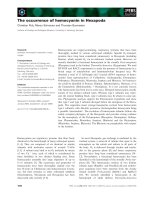


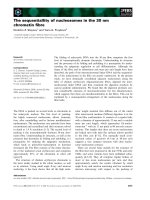
![Tài liệu Báo cáo khoa học: The stereochemistry of benzo[a]pyrene-2¢-deoxyguanosine adducts affects DNA methylation by SssI and HhaI DNA methyltransferases pptx](https://media.store123doc.com/images/document/14/br/gc/medium_Y97X8XlBli.jpg)
